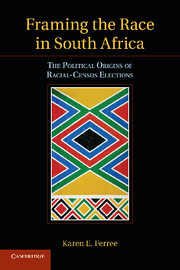Book contents
- Frontmatter
- Contents
- List of Tables
- Acknowledgments
- 1 Introduction
- 2 Voters
- 3 The 1994 Campaigns
- 4 The 1999 Campaigns
- 5 The 2004 Campaigns
- 6 Can a Leopard Change Its Spots? Candidate Demographics and Party Label Change
- 7 Why So Slow? The Political Challenges of Candidate Transformation for Opposition Parties
- 8 Negative Framing Strategies and African Opposition Parties
- 9 Conclusion: South Africa in Comparative Perspective
- References
- Index
- Titles in the series
- References
1 - Introduction
Published online by Cambridge University Press: 06 December 2010
- Frontmatter
- Contents
- List of Tables
- Acknowledgments
- 1 Introduction
- 2 Voters
- 3 The 1994 Campaigns
- 4 The 1999 Campaigns
- 5 The 2004 Campaigns
- 6 Can a Leopard Change Its Spots? Candidate Demographics and Party Label Change
- 7 Why So Slow? The Political Challenges of Candidate Transformation for Opposition Parties
- 8 Negative Framing Strategies and African Opposition Parties
- 9 Conclusion: South Africa in Comparative Perspective
- References
- Index
- Titles in the series
- References
Summary
From an aerial viewpoint, post-apartheid South African elections bear an unmistakable racial imprint: Africans vote for one set of parties, whites support a different set of parties, and, with few exceptions, there is no crossover voting between these groups, which together make up more than 90 percent of the South African population. Such sharp racial contours of voting have earned South African elections the dubious distinction of being “racial censuses:” Voters line up with their racial groups, seemingly without thought to issues, performance, or any of the other politics-as-usual factors that drive elections in other countries. Indeed, elections look so deeply racial that one wonders if politics has anything to do with it at all. What role can persuasion play if voters simply register their social identity when they enter the polling booth?
However, behind the racial imprint lies a puzzle, for racial identities in South Africa are neither pervasive enough nor unique enough to account for South African voting outcomes. African voters – who comprise around three-quarters of the electorate and drive the census – are a highly diverse group; some place primary importance on race, but many more emphasize nonracial identities. Moreover, liberation jubilation aside, Africans have not been uniformly committed to the ruling African National Congress (ANC). Even in 1994, during the very first post-apartheid election campaigns, African voters expressed uncertainty about the ANC. Surveys consistently show a large group of independent Africans, up to 50 percent at some points in the recent past.
- Type
- Chapter
- Information
- Framing the Race in South AfricaThe Political Origins of Racial Census Elections, pp. 1 - 31Publisher: Cambridge University PressPrint publication year: 2010

